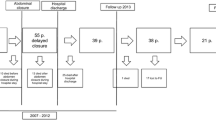Abstract
Background
Open abdomen (OA) treatment with negative-pressure therapy is a novel treatment option for a variety of abdominal conditions. We here present a cohort of 160 consecutive OA patients treated with negative pressure and a modified adaptation technique for dynamic retention sutures.
Methods
From May 2005 to October 2010, a total of 160 patients—58 women (36 %); median age 66 years (21–88 years); median Mannheim peritonitis index 25 (5–43) underwent emergent laparotomy for diverse abdominal conditions (abdominal sepsis 78 %, ischemia 16 %, other 6 %).
Results
Hospital mortality was 21 % (13 % died during OA treatment); delayed primary fascia closure was 76 % in the intent-to-treat population and 87 % in surviving patients. Six patients required reoperation for abdominal abscess and five patients for anastomotic leakage; enteric fistulas were observed in five (3 %) patients. In a multivariate analysis, factors correlating significantly with high fascia closure rate were limited surgery at the emergency operation and a Björk index of 1 or 2; factors correlating significantly with low fascia closure rate were male sex and generalized peritonitis.
Conclusions
With the aid of initially placed dynamic retention sutures, OA treatment with negative pressure results in high rates of delayed primary fascia closure. OA therapy with the technical modifications described is thus considered a suitable treatment option in various abdominal emergencies.




Similar content being viewed by others
References
Brock WB, Barker DE, Burns RP (1995) Temporary closure of open abdominal wounds: the vacuum pack. Am Surg 61:30–35
Miller PR, Meredith JW, Johnson JC et al (2004) Prospective evaluation of vacuum-assisted fascial closure after open abdomen: planned ventral hernia rate is substantially reduced. Ann Surg 239:608–614
Suliburk JW, Ware DN, Balogh Z et al (2003) Vacuum-assisted wound closure achieves early fascial closure of open abdomens after severe trauma. J Trauma 55:1155–1160
Waibel BH, Rotondo MF (2010) Damage control in trauma and abdominal sepsis. Crit Care Med 38(Suppl):S421–S430
Björck M, Bruhin A, Cheatham M et al (2009) Classification: important step to improve management of patients with an open abdomen. World J Surg 33:1154–1157
Boele van HP, Wind J, Dijkgraaf MG et al (2009) Temporary closure of the open abdomen: a systematic review on delayed primary fascial closure in patients with an open abdomen. World J Surg 33:199–207
Bee TK, Croce MA, Magnotti LJ et al (2008) Temporary abdominal closure techniques: a prospective randomized trial comparing polyglactin 910 mesh and vacuum-assisted closure. J Trauma 65:337–342
Schein M, Saadia R, Jamieson JR et al (1986) The ‘sandwich technique’ in the management of the open abdomen. Br J Surg 73:369–370
Jansen J, Loudon M (2007) Damage control surgery in a non-trauma setting. Br J Surg 94:789–790
Leppaniemi A (2009) Surgical management of abdominal compartment syndrome; indications and techniques. Scand J Trauma Resusc Emerg Med 17:17
Mentula P (2011) Non-traumatic causes and the management of the open abdomen. Minerva Chir 66:153–163
Batacchi S, Matano S, Nella A et al (2009) Vacuum-assisted closure device enhances recovery of critically ill patients following emergency surgical procedures. Crit Care 13:R194
Regner JL, Kobayashi L, Coimbra R (2012) Surgical strategies for management of the open abdomen. World J Surg 36:497–510
Perathoner A, Klaus A, Mühlmann G et al (2010) Damage control with abdominal vacuum therapy (VAC) to manage perforated diverticulitis with advanced generalized peritonitis: a proof of concept. Int J Colorectal Dis 25:767–774
Petersson U, Acosta S, Bjoerck M (2007) Vacuum-assisted wound closure and mesh-mediated fascial traction: a novel technique for late closure of the open abdomen. World J Surg 31:2133–2137
Wondberg D, Larusson HJ, Metzger U et al (2008) Treatment of the open abdomen with the commercially available vacuum-assisted closure system in patients with abdominal sepsis: low primary closure rate. World J Surg 32:2724–2729
Gäddnäs F, Saarnio J, Ala-Kokko T et al (2007) Continuous retention suture for the management of open abdomen: a high rate of delayed fascial closure. Scand J Surg 96:301–307
Pliakos I, Papavramidis TS, Mihalopoulos N et al (2010) Vacuum-assisted closure in severe abdominal sepsis with or without retention sutured sequential fascial closure: a clinical trial. Surgery 148:539–947
Verdam FJ, Dolmans DE, Loos MJ et al (2011) Delayed primary closure of the septic open abdomen with a dynamic closure system. World J Surg 35:2348–2355
Acosta S, Bjarnason T, Petersson U et al (2011) Multicentre prospective study of fascial closure rate after open abdomen with vacuum and mesh-mediated fascial traction. Br J Surg 98:735–743
Demmel N, Maag K, Osterholzer G (1994) Wertigkeit klinischer parameter zur prognosebeurteilung der peritonitis: validierung des mannheimer peritonitis-index. [The value of clinical parameters for determining the prognosis of peritonitis: validation of the mannheimer peritonitis index]. Langenbecks Arch Surg 379:152–158
Ohmann C, Hau T (1997) Prognostic indices in peritonitis. Hepatogastroenterology 44:937–946
Horwood J, Akbar F, Maw A (2009) Initial experience of laparostomy with immediate vacuum therapy in patients with severe peritonitis. Ann R Coll Surg Engl 91:681–687
Ozgüç H, Yilmazlar T, Gürlüler E et al (2003) Staged abdominal repair in the treatment of intra-abdominal infection: analysis of 102 patients. J Gastrointest Surg 7:646–651
Ivatury RR (2009) Update on open abdomen management: achievements and challenges. World J Surg 33:1150–1153
Vlug MS, Bartels SA, Wind J et al (2011) Which fast track elements predict early recovery after colon cancer surgery? Colorectal Dis. doi:10.1111/j.1463-1318.2011.02854.x
Author information
Authors and Affiliations
Corresponding author
Rights and permissions
About this article
Cite this article
Kafka-Ritsch, R., Zitt, M., Schorn, N. et al. Open Abdomen Treatment with Dynamic Sutures and Topical Negative Pressure Resulting in a High Primary Fascia Closure Rate. World J Surg 36, 1765–1771 (2012). https://doi.org/10.1007/s00268-012-1586-0
Published:
Issue Date:
DOI: https://doi.org/10.1007/s00268-012-1586-0




